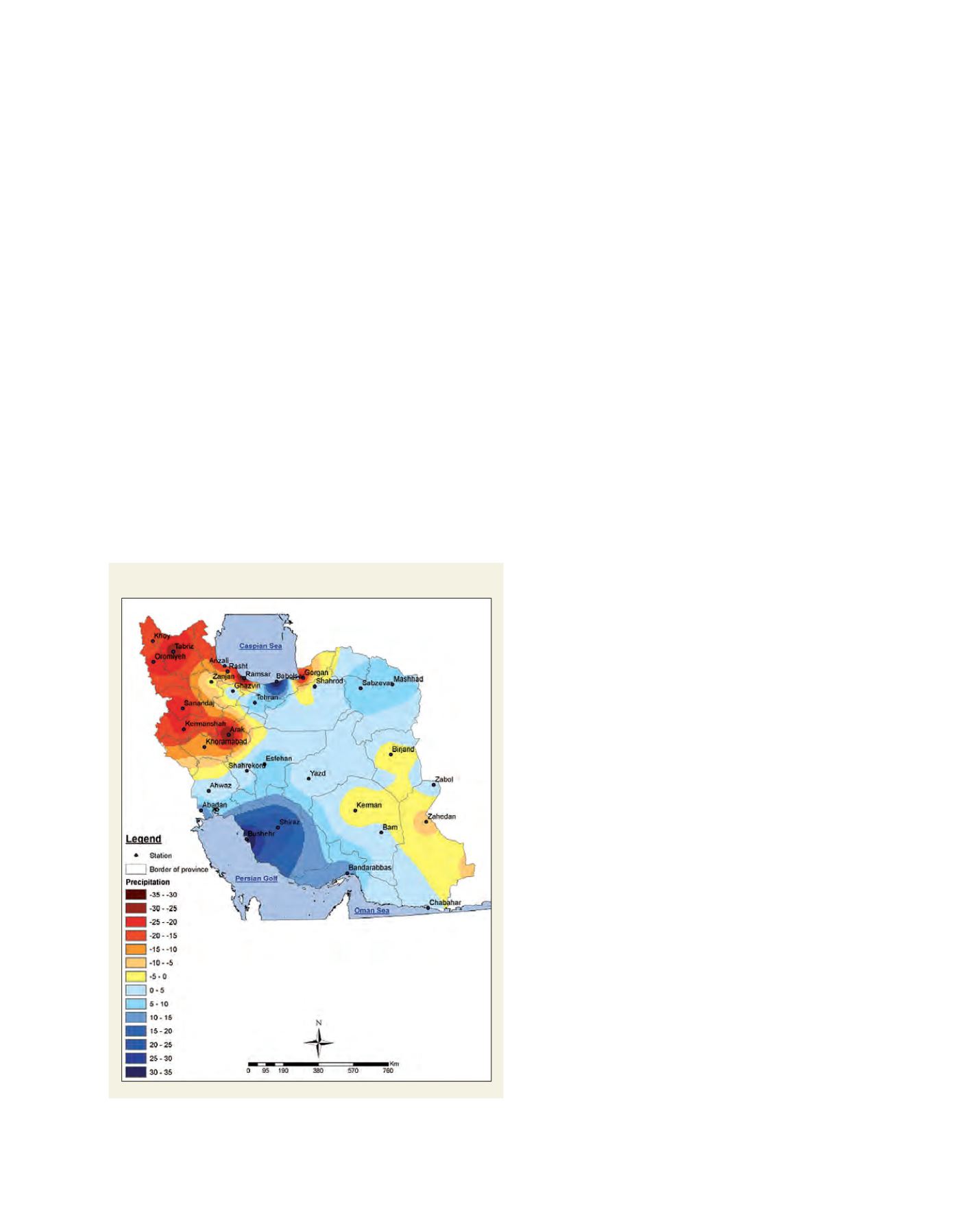

[
] 234
A
dAptAtion
And
M
itigAtion
S
trAtegieS
In 2003 and 2004 relatively wet conditions across south-
west Asia helped to ease the effects of the drought somewhat.
However, these beneficial conditions did not continue
and drought came back to the region in 2005. Despite the
drought, Iran also experienced heavy snow in early 2005
combined with a warm boreal spring. These conditions
generated widespread flooding in the local basins.
Dust storms are seasonal phenomena in the east of
Iran, occurring when a particular synoptic condition is
dominant in the region. However, the intensity of said
phenomena has increased gradually and spread out over
a wider area, so that it now affects parts of Afghanistan,
southeastern Iran and western Pakistan during summer
and autumn. Due to these increases in severity and scope
the dust storms constitute a greater and more hazardous
health risk to human beings. Furthermore, during the past
few years these conditions have spread into the southwest
of the country – though it is worth noting that the regional
source of the dust differs for the different areas affected.
8
Climate change and variability has affected the crop
season in Iran, shortening the growing period and thus
resulting in crop yield decline. Acute water shortage
combined with thermal stress has affected wheat and rice
productivity, with many species in Iran becoming extinct
as a result of the synergistic effects of climate change.
Furthermore, warmer surface temperatures have created
favourable conditions for forest fires.
Increased intensity and spread of forest fires in Asia has
been observed in recent decades, with climate change –
in combination with intense land use – the likely cause.
Biodiversity in Asia is also being lost as a result of devel-
opment activities and continuous land degradation.
In order to enhance adaptation efforts Iran must
monitor climate extremes closely, as well as variability
and the rate of change. It must also assess the poten-
tial impacts of climate change, as well identify people or
areas that are most vulnerable. Based on these actions
we can implement sound adaptation measures. Iran’s key
aims relating to climate change adaptation are to:
• Increase awareness among people and policy makers
• Establish adequate observing systems
• Make full use of software and hardware facilities
• Establish an appropriate climate database
• Create better links with users
• Build capacity in human resources and
infrastructure
• Increase use of advanced methodologies and new
technologies
• Harmonize adaptation programmes regionally
• Use financial resources efficiently.
The Islamic Republic of Iran Meteorological Organization
– along with other governmental organizations and non-
governmental organizations – aims to enable the country
to achieve these objectives, especially in the areas of
capacity building and adaptation measures. Asian coun-
tries, including Iran, which are vulnerable to climate
change and have limited potential to enhance adaptive
capabilities should expand their activities.
than long-term recorded temperatures in December. Snow and cold
weather affected the north of the country, while heavy rainfall flooded
some areas in the south and east of Iran.
Cyclone Gonu caused heavy rainfall on the southeastern coastline
of Iran, resulting in flooding and heavy damage. Local observation
stations in the Sisitan-Balochistan and Hormozgan provinces – where
the annual mean precipitation is less than 200 millimetres – expe-
rienced 62 to 111 millimetres of rainfall on 6 June 2007.
5
Waves in
Oman and the Persian Gulf reached heights of 6 to 10 metres as a
result of storm surge.
6
Intensive rain and floods damaged road and
telecommunication links, and disrupted drinking water supplies to
villages in the southeast of the Sistan-Baluchestan province. During
the summer of 2007, despite most parts of Iran receiving no consid-
erable rainfall, the Sistan-Balochestan province, as well as western
Afghanistan and Pakistan, experienced precipitation 200 to 300 per
cent above their long-term recorded averages.
The frequency of drought has also increased in Iran over recent
decades. The region experienced severe drought during the prolonged
1998–2002 cold phase La Niña event, as well as unusually warmwater
temperatures in the western Pacific and eastern Indian Oceans.
7
The
severe drought affecting the southeast of Iran continued for seven
years causing crop failure, livestock loss and mass migration – which
in turn resulted in serious problems for the local economy, as well as
people’s livelihood.
Source: Dr A.M. Noorian and F. Rahimzadeh: I. R. of Iran Meteorological Organization
(IRIMO) and Atmospheric Science and Meteorological Research Center (ASMERC)
Decadal trend of precipitation during the period 1960-2005
















